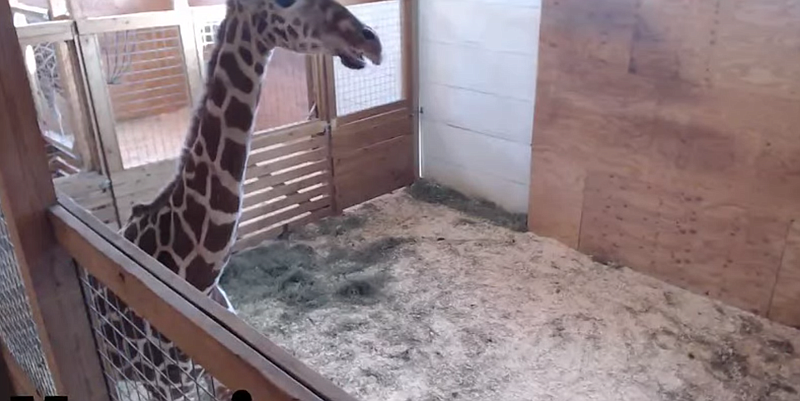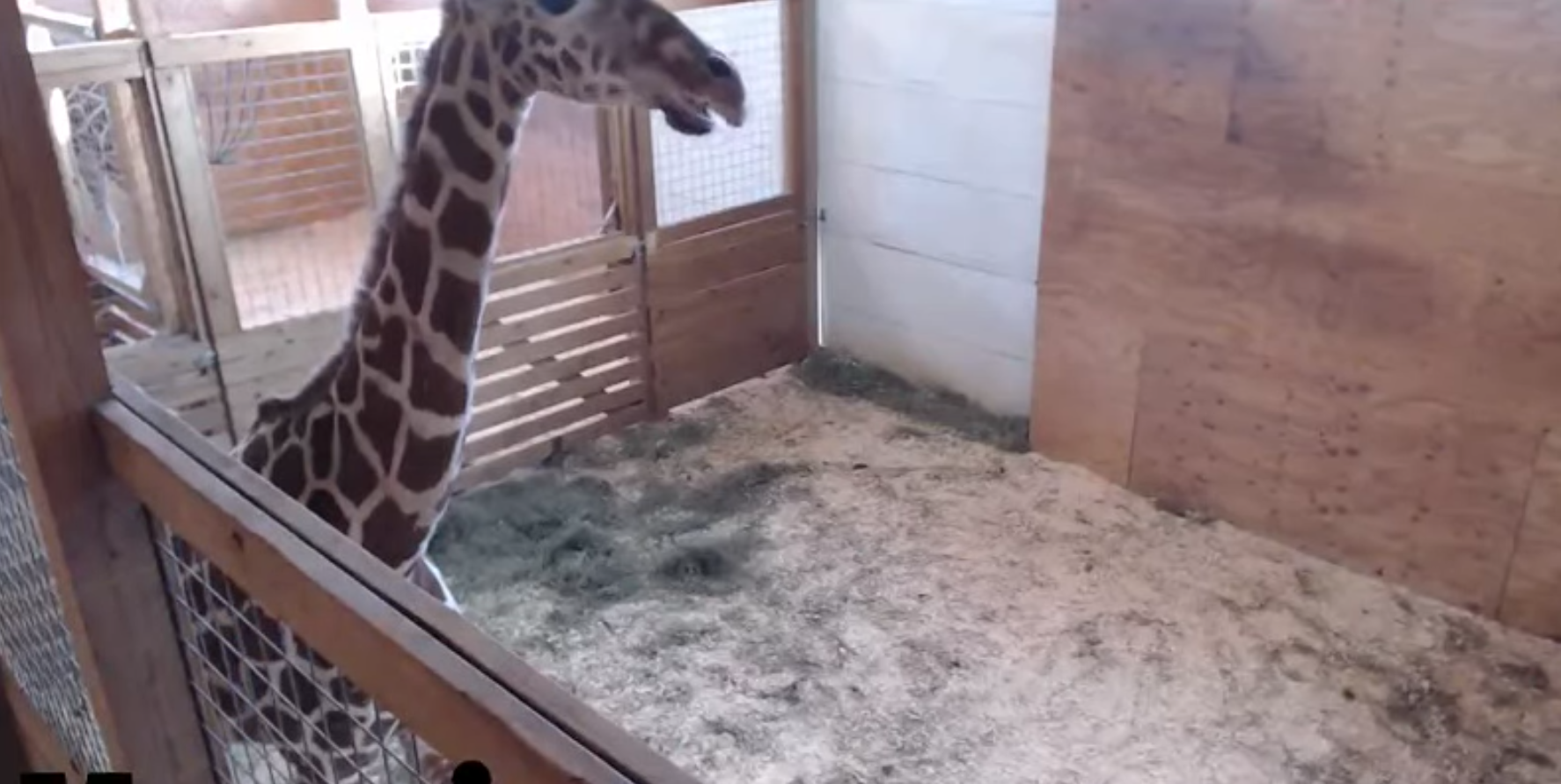An April due date?
Zookeepers at Animal Adventure Park initially believed April the Giraffe was due in mid-February, but the wait goes on.Zoo owner Jordan Patch told ABC affiliate WFAA Channel 8 that it’s unlikely viewers will be able to tell April’s in labor until they see an actual hoof begin to poke from the birth canal. Giraffes instinctively hide their labor for however long it’s lasting so as not to draw attention from predators that will wait out a giraffe’s labor to attack once the calf is born. One sign of active labor is when the giraffe’s water breaks, he said. It can be anywhere from a slow trickle of liquid to a flow of mucous, according to a story posted at www.wfaa.com.The giraffey couple› April is 15 years old. This is her fourth calf.› Oliver is 5. This is his first calf.› Their offspring will be the first giraffe calf born at Animal Adventure Park.› Their calf will weigh about 150 pounds and stand about 6 feet tall at birth.› The front hooves will come out first, followed by the snout.› April will raise the calf alone. Male giraffes, called bulls, care only about fighting and breeding. They take no part in rearing young.Source: www.aprilthegiraffe.com
Friday morning in upstate New York, April the Giraffe was still pacing her pen, her swollen stomach and slowing pace seeming to indicate her 15-month pregnancy might soon end. Zookeepers at Animal Adventure Park in Harpursville believe her calf is due any day.
When that leggy, necky bundle of joy arrives, millions will be watching. April's pen is linked to the outside world via a YouTube livestream that captures the 15-year-old giraffe's every move.
Friday morning in Chattanooga, there was no baby mama drama, but there was plenty of animal action. Or inaction, depending on the animal.
At the Tennessee Aquarium, a lone river otter swam in circles and scampered across the rocks of River Otter Falls. Sharks and a scuba diver glided past the Secret Reef Cam. At Penguins' Rock, the gentoos and macaronis stood sentinel on the rocks, taking a break from the pool.
At Chattanooga Zoo, the cotton-top tamarins offered a few flips and scampers, while meerkats played hide-and-seek in their sandy habitat. The Snow Leopard Cam, though, offered only an occasional bird alighting sighting. The snow leopards, for the moment, were MIA in an off-camera section of their enclosure.
For a five-minute remote tour, that's the luck of the draw. The animals aren't there to entertain. Officials say that to the best of their knowledge, the animals don't even know the cameras are there.
"Our cameras are strategically placed to get the best angle of the animals' exhibit, but as far as we know, our animals are not aware of the cameras themselves," says Hannah Hammon, spokeswoman for Chattanooga Zoo.
It's a similar story for the three cameras at the Tennessee Aquarium, says spokesman Thom Benson. All are in elevated positions for an all-encompassing view.
"The placements are intentional so the cameras remain out of the sight lines of guests while providing a great view of the animals and exhibit," Benson says. "In the case of River Otter Falls, the camera is embedded in the decorative rock work of the habitat. The only time the penguins notice the camera is when someone needs to adjust it to zero in on a penguin nest with chicks."
The technology is made possible by EPB, which sponsors all of the in-house cameras as well as an off-site "gator cam" especially designed for tourists.
This eye-popping display requires a visit to the Chattanooga Metropolitan Airport, which last year installed a 98-inch Planar UltraRes 4K display screen in the lobby to show a live feed of the aquarium's alligator exhibit. Nokia Corp. teamed with EPB's gigabit network for the display, making it the first time any city in the world has used live ultra-high-definition video for tourism, according to Times Free Press archives.

Benson says the aquarium hosts the cameras on a special service, "but it's the power of EPB's high-speed connection that allows the video to stream smoothly."
In fact, he says, EPB's connection was so fast "it took quite a bit of time for the 4K live streaming project to be unveiled here."
"Initially the team working on the live stream could not find a 4K camera that could handle the relatively low light environment of the Secret Reef while streaming the fast-moving fish smoothly (at the highest resolution)," he explains. "It was a real hurdle that forced us to install a camera in the Alligator Bayou exhibit, which has much better lighting."
The technology has already evolved, he says, and the aquarium recently installed a new camera that "can keep up with EPB's blazing-fast internet connection. We are working toward switching to the Secret Reef 4K video stream at the airport soon."
Both Hammon and Benson say remote viewings draw thousands of onlookers to the websites.
"We have many zoo supporters that live out of state who regularly watch the livestreams," Hammon says. Of the three cameras at the zoo, the meerkat livestream is "probably the most viewed."
Benson says the aquarium also has received positive feedback over the years.
"When we first installed the Penguins' Rock camera, we heard some great stories about Army reservists watching the penguins in the Middle East. One grandmother emailed us to let us know she was watching from Arizona while her son was watching with her granddaughters in South America."
And Benson says there's evidence to support the health benefits of keeping an eye on the animals, especially the fish.
"We hear from people who enjoy taking a stress break at work while watching the Secret Reef camera," he says. "And there are numerous scientific reports supporting the health benefits of visiting aquariums - lowering blood pressure, etc. So it seems like watching saltwater fish, penguins or otters would be a good thing to do."
Of course, animals being animals, there's always the possibility of PG-13 behavior on camera.
The livestream of April the Giraffe was temporarily taken offline in February after complaints were made to YouTube about the ongoing pregnancy watch violating the site's nudity guidelines, according to The Associated Press. Zoo owner Jordan Patch blamed the brief interruption on "a handful of extremists and animal rights activists."
Hammon says there's "always gong to be a risk of seeing something questionable on a live animal stream. Viewers may see breeding, scuffles between the group or anything else, but these behaviors are normal in animals."
Benson says they've had no complaints of any so-called questionable behavior. "Unless you're watching the romantic courtship behaviors in Penguins' Rock each year."
The penguins' nesting rocks will go out on display again this year on April 3, he reports.
Then Chattanooga can brace for its own baby mama drama.
Contact Lisa Denton at ldenton@timesfreepress.com or 423-757-6281.

